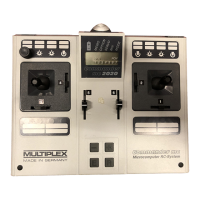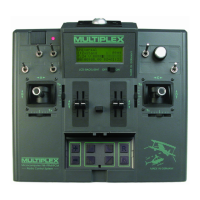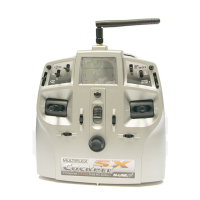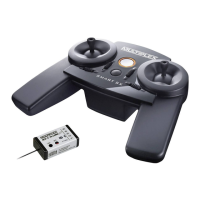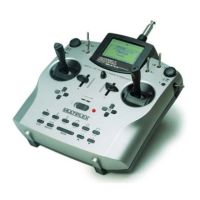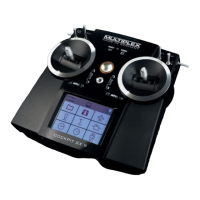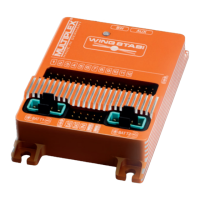"two
in,
two
out"
The
X-,!tXfunction
mixes
the
signals
from
two transmitter
controls
and
passes
the
resultant signal to two
servos.
The
signals
are mixed
in both directions,
hence the letm
x-MlX.
The
diagram
on the
right
shows
how
x-Mlx wotks. The signals
from
controls
1
and
2 arc mixed and
passed
to
servos
'1
and
2.
X-MIXis atrcely assignable
mixer, i.e. any two transmitter
controls can
be
mixed.
For each of the two controls
separately
you
can set lhe
magnitude of the
servo
response.
The range
of
values is 0% to
100%.
One transmitter
control
moves
bolh servos
in the same direction ol
rotation, the other
moves
lhem
in opposite direclions.
The
direction
in
which the controls
work
can
also be
reversed, naturally.
Since the
X-[t Xfeature can be assigned to
any channels, adjusted and
reversed,
it
can be used
lor a very
wide variety
of applications.
How do
you
use
X-MIX?
This type of
mixer is very versatile. The two
most
common
applications
Fig l1:
in model aircraft are described
brieflv below. and
illustrated in the
x'mi\er
diagrams.
The
BOATS section describes a
further example,
namely
the use of
the
mixer
in
a twin-engined
boat to
reinforce
the
elfect of the
rudder
system.
V-tail
A typical application
fo( X-MIX
is
controlling
a V{ail.
ln
this case the
signals
for RUDDER and
ELEVATOR have to be
mixed
and
passed
to
two seoarate
servos.
A V-tail system
is
described
in detail
later
as an example
for X-MIX.
DELTA
(flying
wing model aircraft)
In deltas and
flying
wings
the signals
for AILEBON and
ELEVATOR are
mixed and oassed
on to two servos.
When an
AILERON command
is
given,
the elevons
move in
opposite
directions
(one
up, the other down).
When an
ELEVATOR command
is
given,
the elevons
move in
the
same
direction
(both
up or
both down).
How do
you
select
the transmitter
controls
for X-MIX?
a.)
ff the mixer
has not
yet
been activated:
lf
you
have
not
used
X-,lt X
in
the currently active
model
memory,
or
have erased
that
memory,
you
must first select the two lransmitter
controls
for
the
mixer. The mixer
is
then activated,
and the two
inputs
(signals)
are
mixed,
both at
100%, and
passed
on to
the two servos.
After
you
have selected the controls,
the transmitter
gives you
the
chance
to set the
magnitude of the mixer
inputs
and
their direction ol
working.
b.)
fi X-MIX
has
already
been activated:
ln this case
you
can either
.
select one or both
transmitter controls
anew, or
.
alter the
input
and
direction
for
one
(or
both)
controls.
lf
your
transmitter
is brand-new there
will
generally
be
no
active
mixers
set.
For this
reason we will deal lirst
with
case a.).
IEEI,
,
417
GB-15-
Manual EUROPA mc

